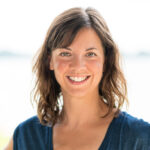Chalvar Monteiro and Maleek Washington demonstrate a basic arm phrase from Kyle Abraham’s The Radio Show.
Ask middle school students their thoughts about a modern dance performance and watch how quickly the battle of “I loved it!” or “I hated it!” begins. Too often young dance students have tunnel vision on physical training and rarely care to see performances outside their personal aesthetic. But K–12 education should expand students’ field of vision. By guiding their eyes to openly observe and their minds to analyze the viewing experience, you can teach your students to appreciate a variety of choreographic styles.
The 92nd Street Y Harkness Dance Center in New York City created a new course this spring for just that purpose. Over the five weeks of the Dance Education Lab (DEL)/Harkness Dance Festival Intensive, a group of 16 K–12 educators attended performances and worked with the dance company members in the studio, all with the goal to help their students view, understand and talk about dance.
This year’s Harkness Dance Festival was inspired by choreographer and festival curator Doug Varone’s Stripped/Dressed performance concept, wherein the audience is given a peek into the creative process to see what the choreographers are motivated by and how the editing process shapes their work. Before performing, the choreographers informally share their unique modes of movement generation and their approach to themes and music.
Educators participating in the DEL/Harkness Dance Festival Intensive attended the five festival performances, then they spent four hours working in the studio with each company to delve into the creative devices and choreographic themes of the work. The 2014 intensive included Kyle Abraham, casebolt and smith, Nora Chipaumire, Netta Yerushalmy and David Dorfman—an innovative and eclectic group of choreographers.
“We learn directly from the choreographer or company member how their work is created, then we establish connections between these choreographic strategies and the NYCDOE Dance Blueprint,” says Ana Nery Fragoso, Dance Education Laboratory faculty member and intensive facilitator, referring to the New York City Department of Education’s curriculum guidelines for teaching dance. The workshop is unique in its focus on guiding dance educators to become well-informed viewers, not just dancers.
The first half of class is for improvisational and imaginative tasks, so participants can get a flavor for the choreographer’s way of working. “The choreographer designs strategies to help us create movement material on the spot,” says Fragoso.
The second half puts these strategies and themes into practical classroom perspective, using such tools as Laban Movement Analysis categories of body, dynamics, space and relationship. Participants have time to brainstorm ideas for K–12 dance curriculum and formulate lesson plans.
For students to effectively discuss a choreographic work, Fragoso suggests they experiment with creating choreography, developing their personal voices. One of the workshop’s main goals was to spark ideas for guiding the creative process, to ultimately open students’ minds to all styles of choreography.
Kyle Abraham’s workshop, taught by company member Chalvar Monteiro, began with an arm phrase from Abraham’s piece The Radio Show. He then guided the group through a loosely structured improv—create three arm gestures that repeat, while the legs and body move freely below—then scaffolded new ideas onto the initial task. He requested level changes, encouraged borrowing other dancers’ gestures, incorporated music changes and finally opened the improv into a circle wherein three people were moving at all times. The participants were excited that the structure allowed them to become a cohesive group discovering a common thread, regardless of their varied training backgrounds.
Joel Smith and Liz Casebolt worked with K–12 educators during The Harkness Dance Festival.
An underlying premise of the intensive is to reveal that no matter how complex a work appears onstage (especially when performed by virtuosic professionals), there is often a simple beginning structure. For example, one of Abraham’s basic movement tasks works for all ages: Dancers must travel from one side to the other using three action words, such as dive, wiggle and pop. Netta Yerushalmy also used a word-oriented game, making movement sentences inspired by words in a Gertrude Stein novel. “For younger students, you could use a Dr. Seuss book and create a simple gesture for each word,” says Fragoso.
Going hand in hand with comprehending choreography is the need for a common vocabulary for students and teachers to discuss dance. This language elicits clear observations, descriptions and evaluations of their experience watching movement. The course description states that educators will honor their students’ “emotional and instinctive responses,” while guiding them to express responses more mindfully than saying “I liked it!” As Fragoso puts it, “We as teachers must learn how to form and ask open-ended questions, so students really analyze the work in their own way.” For more: danceeducationlaboratory.com DT
Jen Peters is a former dancer with Jennifer Muller/The Works.
Photo (top) by Julie Lemberger, courtesy of 92nd St. Y; by Mariliana Arvelo, courtesy of 92nd Street Y




